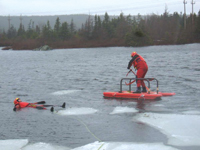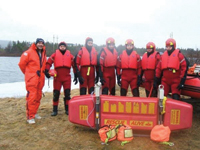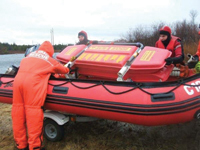
Features
Structural
Training
Training days
Harbour Grace, N.L. – Many firefighters train in ice/water rescue but not all use these specialized skills over the course of their careers. Recently the Harbour Grace Volunteer Fire Brigade was tested in an incident involving teenage boys, risks and, unfortunately, tragedy.
February 4, 2009
By Robert Lynch
Cold-water rescue course in Harbour Grace has evolved into NFPA-recognized program
 |
| Firefighters in Prince Edward County, Ont., do hands-on training in a cold-water rescue program similar to the one implemented in Harbour Grace.
|
Harbour Grace, N.L. – Many firefighters train in ice/water rescue but not all use these specialized skills over the course of their careers. Recently the Harbour Grace Volunteer Fire Brigade was tested in an incident involving teenage boys, risks and, unfortunately, tragedy.
On Dec. 21, two 15-year-old boys disappeared during an afternoon ride on their all-terrain vehicle. At press time, the bodies of Max Antle-Sharpe and Ryan Coombs hadn’t been recovered. Tire tracks ending at the top of a sheer cliff in an area known as The Meadow led searchers to the Atlantic Ocean below. Several rescue agencies were involved in the unsuccessful search along with Harbour Grace’s cold-water rescue team. (See Station to Station, page 6.)
Many volunteer departments lack the resources to create specialized rescue teams. The Harbour Grace Fire Brigade has always been aggressive in training its members to the latest standards. Like many communities, Harbour Grace and surrounding areas have many ponds, which during the winter are used for ice fishing, snowmobiling and as a means for local residents to haul firewood out by horse and snowmobile. There are also kilometres of cliffs and ocean frontage. The brigade realized that the risk for danger was too great to ignore and in the later part of 1998 started looking into the requirements for a cold-water rescue team. Prior to this, many of the team members had never donned any sort of suit – wet or dry.
 |
|
| Rescue technician Shawn Baker prepares to rescue a casualty using the apparatus Rescue Alive. |
|
 |
|
| Instructor Bill Ryan with rescue technicians David Earle, Charles Archibald, Chris Noel, Philip Peddle, Sonia Williams and Shawn Baker. After completion of the NFPA Certified Ice / Water Rescue Course on April 19, 2008. |
|
 |
|
| Rescue technicians Charles Archibald and David Earle, with the help of a shore tender, secure the Rescue Alive in the rescue Zodiac.
|
With the help of MP Fred Mifflin, a federal grant was made available to train and outfit a cold-water rescue team. In early spring of 1999, 17 members started the training course instructed by Jack Wood of J4 Survival, under the direction of the Canadian Coast Guard.
The course included classroom instruction, swimming-pool sessions and open-water practice. The classroom sessions included videos of rescues and recoveries, discussion on proper rescue techniques and lectures on cold-water related injuries and casualty care, handling and treatment.
At the swimming pool, would-be rescuers were required to complete drills that tested their endurance, stamina, swimming ability and mental awareness while completing rescues. They were also taught the procedures necessary to do a proper size-up of a rescue situation and complete rescues involving varying degrees of injury. The final pool session involved suiting up in neoprene dry suits and performing rescue drills. Then came the team’s open-water training, which included an evaluation in lake and ocean conditions.
The ice/water rescue course has evolved over the years. It now includes the principles of Wood’s course and adaptations to ice/water conditions, training in the use of rescue apparatus such as the Rescue Alive emergency rescue sled (www.angelguardproducts.com), and the rescue harness. Team members are also part of the department’s rapid intervention team and have been trained as safety officers. In addition, the ice/water rescue team trains with the rescue Zodiac in casualty rescue and recovery.
Bill Ryan has been in charge of Harbour Grace’s ice/water rescue training since 1999.
“Our training is ever evolving, including testing and evaluation as new techniques and apparatus are introduced,” Ryan says. “Our training program focuses on the lasted rescue techniques while maintaining the basic principles of water/ice rescue and casualty care and treatment. We try to achieve all of this while keeping
the safety of everyone a first priority.”
Ryan says much progress has been made in ice/water rescue. The team’s Zodiac includes casualty retrieval apparatus, which allow one rescuer to bring a casualty aboard the Zodiac with little effort. Also, many team members have earned their small boat and craft operator’s licences. Rescues and recoveries using the Zodiac are a regular part of the training program.
Team members have been challenged to complete training practices, which consist of classroom and swimming-pool sessions, outside sessions in open water and ice conditions. Ryan has created a list of standard operating guidelines that are followed by all team members during training and rescue exercises.
During the week of March 10, 2008, in collaboration with the St. John’s Regional Fire Department and with the support from the Harbour Grace Volunteer Fire Brigade, Ryan completed a week-long instructor’s level course in ice/water rescue, which is compliant with NFPA standards. As a result, Ryan modified Harbour Grace’s in-house course and it is now recognized by the NFPA.
Over the past 10 months, a number of members have completed the ice/water rescue course. The course, developed by Ryan in accordance with NFPA standards, consists of three levels of training: awareness; operational; and rescue technician. The team presently consists of 29 members – 21 members trained in awareness and operational and eight members trained in all three levels and recognized as rescue technicians.
The awareness level includes classroom sessions and prepares members to recognize dangerous situations, no-risk rescues and assist in rescue exercises.
The operational level provides training to the members, making them capable of assessing the rescue, preparing the apparatus for rescue and assisting the rescue technician.
“With the rescue technician level, our members will size up the situation, determine the proper rescue procedure and finally carry out the rescue in the safest possible manner,” Ryan explains.
“We have been conducting our own training, evaluations and testing, which include numerous ice/water rescues in extreme conditions as well as night exercises. The implementation of this new modified course, with an emphasis on safety, has taken our training to a higher level that is recognized by NFPA standards. And, being able to certify team members to this standard made the effort all the better.”
Harbour Grace Brigade Chief Sonia Williams has completed all three levels of this course.
“Sending Bill to this course was an asset to the brigade members and the public in the greater Conception Bay area,” she says. “We already had a good cold-water rescue program in place, but Bill came back with a more challenging program. We have now upgraded the team with the purchase of more equipment to use during rescues and we have addressed safety issues for the rescuer as well.”
For more information on the course contact Bill Ryan at billryan@personainternet.com
Print this page